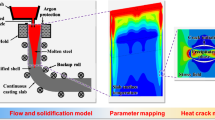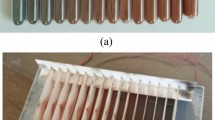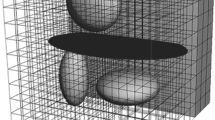Abstract
This paper presents a method for simulating surface crack patterns appearing in ceramic glaze, glass, wood and mud. It uses a physically and heuristically combined method to model this type of crack pattern. A stress field is defined heuristically over the triangle mesh of an object. Then, a first-order quasi-static cracking node method (CNM) is used to model deformation. A novel combined stress and energy combined crack criterion is employed to address crack initiation and propagation separately according to physics. Meanwhile, a highest-stress-first rule is applied in crack initiation, and a breadth-first rule is applied in crack propagation. Finally, a local stress relaxation step is employed to evolve the stress field and avoid shattering artifacts. Other related issues are also discussed, such as the elimination of quadrature sub-cells, the prevention of parallel cracks and spurious crack procession. Using this method, a variety of crack patterns observed in the real world can be reproduced by changing a set of parameters. Consequently, our method is robust because the computational mesh is independent of dynamic cracks and has no sliver elements. We evaluate the realism of our results by comparing them with photographs of real-world examples. Further, we demonstrate the controllability of our method by varying different parameters.
Similar content being viewed by others
Explore related subjects
Discover the latest articles and news from researchers in related subjects, suggested using machine learning.References
O’Brien J F, Hodgins J K. Graphical modeling and animation of brittle fracture. In: Proceedings of the 26th Annual Conference on Computer Graphics and Interactive Techniques. 1999, 137–146
Pfaff T, Narain R, de Joya JM, O’Brien J F. Adaptive tearing and cracking of thin sheets. ACM Transactions on Graphics, 2014, 33(4): 1–9
Song J H, Belytschko T. Cracking node method for dynamic fracture with finite elements. International Journal for Numerical Methods in Engineering, 2009, 77(3): 360–385
Molino N, Bao Z, Fedkiw R. A virtual node algorithm for changing mesh topology during simulation. ACM Transactions on Graphics, 2004, 23(3): 385
Belytschko T, Black T. Elastic crack growth in finite elements with minimal remeshing. International Journal for Numerical Methods in Engineering, 1999, 45(5): 601–620
Melenk J, Babuška I. The partition of unity finite element method: basic theory and applications. Computer Methods in Applied Mechanics and Engineering, 1996, 139: 289–314
Rabczuk T. Computational methods for fracture in brittle and quasibrittle solids: state-of-the-art review and future perspectives. Applied Mathematics, 2013, 2013: 1–38
Lindblad A, Turkiyyah G. A physically-based framework for real-time haptic cutting and interaction with 3D continuum models. In: Proceedings of ACM Symposium on Solid and Physical Modeling. 2007, 421–429
Chao S. Simulation for cutting deformable model based on X-FEM. In: Proceedings of International Conference on Intelligent Computing and Cognitive Informatics. 2010, 436–439
Kaufmann P, Martin S, Botsch M, Grinspun E, Gross M. Enrichment textures for detailed cutting of shells. ACM Transactions on Graphics, 2009, 28(3): 50
Jerábková L, Kuhlen T. Stable cutting of deformable objects in virtual environments using XFEM. IEEE Computer Graphics and Applications, 2009, 29(2): 61–71
Turkiyyah G M, Karam W B, Ajami Z, Nasri A. Mesh cutting during real-time physical simulation. In: Proceedings of SIAM/ACM Joint Conference on Geometric and Physical Modeling. 2009, 159–168
Iben H N, O’Brien J F. Generating surface crack patterns. Graphical Models, 2009, 71(6): 198–208
Muguercia L, Bosch C, Patow G. Fracture modeling in computer graphics. Computers Graphics, 2014, 45: 86–100
Terzopoulos D, Platt J, Fleischert K. Elastically deformable models. Computer Graphics, 1987, 21(4): 205–214
Terzopoulos D, Fleischer K. Modeling inelastic deformation: viscolelasticity, plasticity, fracture. ACM SIGGRAPH Computer Graphics, 1988, 22(4): 269–278
Wu J, Westermann R, Dick C. A survey of physically based simulation of cuts in deformable bodies. Computer Graphics Forum, 2015, 34(6): 161–187
Norton A, Turk G, Bacon B, Gerth J, Sweeney P. Animation of fracture by physical modeling. The Visual Computer, 1991, 7(4): 210–219
Lloyd B A, Szekely G, Harders M. Identification of spring parameters for deformable object simulation. IEEE Transactions on Visualization and Computer Graphics, 2007, 13(5): 1081–1094
Natsupakpong S, Çavusoglu M C. Determination of elasticity parameters in lumped element (mass-spring) models of deformable objects. Graphical Models, 2010, 72(6): 61–73
Liu T T, Bargteil A W, O’Brien J F, Kavan L. Fast simulation of massspring systems. ACM Transactions on Graphics, 2013, 32(6): 214
Kot M, Nagahashi H, Szymczak P. Elastic moduli of simple mass spring models. The Visual Computer, 2015, 31(10): 1339–1350
Levine J A, Bargteil A W, Corsi C, Tessendorf J, Geist R. A peridynamic perspective on spring-mass fracture. In: Proceedings of the ACMSIGGRAPH/Eurographics Symposium on Computer Animation. 2014, 47–55
O’Brien J F, Bargteil A W, Hodgins J K. Graphical modeling and animation of ductile fracture. ACM Transactions on Graphics, 2002, 21(3): 291–294
Bao Z S, Hong J M, Teran J, Fedkiw R. Fracturing rigid materials. IEEE Transactions on Visualization and Computer Graphics, 2007, 13(2): 370–378
Busaryev O, Dey T K, Wang H. Adaptive fracture simulation of multilayered thin plates. ACM Transactions on Graphics, 2013, 32(4): 52
Matthias M, Gross M, Müller M. Interactive virtual materials. In: Proceedings of Graphics Interface. 2004, 239–246
James D L, Pai D K. Artdefo: accurate real time deformable objects. In: Proceedings of the 26th Annual Conference on Computer Graphics and Interactive Techniques. 1999, 65–72
Kielhorn L. A time-domain symmetric Galerkin BEM for viscoelastodynamics. Dissertation for the Doctoral Degree. Graz: Graz University of Technology, 2009
Zhu Y, Bridson R, Greif C. Simulating rigid body fracture with surface meshes. ACM Transactions on Graphics, 2015, 34(4): 150
Hahn D, Wojtan C. High-resolution brittle fracture simulation with boundary elements. ACM Transactions on Graphics, 2015, 34(4): 151
Müller M, Keiser R, Nealen A, Pauly M, Gross M, Alexa M. Point based animation of elastic, plastic and melting objects. In: Proceedings of ACM SIGGRAPH/Eurographics Symposium on Computer Animation. 2004, 141–151
Pauly M, Keiser R, Adams B, Dutré P, Gross M, Guibas L J. Meshless animation of fracturing solids. ACM Transactions on Graphics, 2005, 24(3): 957–964
Solenthaler B, Schläfli J, Pajarola R. A unified particle model for fluidsolid interactions. Computer Animation and Virtual Worlds, 2007, 18(1): 69–82
Li C, Wang C B, Qin H. Novel adaptive SPH with geometric subdivision for brittle fracture animation of anisotropic materials. The Visual Computer, 2015, 31(6): 937–946
Liu N, He XW, Li S, Wang G P. Meshless simulation of brittle fracture. Computer Animation and Virtual Worlds, 2011, 22(2-3): 115–124
Hesham O. Fast meshless simulation of anisotropic tearing in elastic solids. Dissertation for the Doctoral Degree. Ottawa: Carleton University, 2011
Sifakis E, Der K G, Fedkiw R. Arbitrary cutting of deformable tetrahedralized objects. In: Proceedings of ACM SIGGRAPH/Eurographics Symposium on Computer Animation. 2007, 73–80
Wang Y T, Jiang C, Schroeder C, Teran J. An adaptive virtual node algorithm with robust mesh cutting. In: Proceedings of ACM SIGGRAPH/Eurographics Symposium on Computer Animation. 2014, 77–85
Glondu L, Marchal M, Dumont G. Real-time simulation of brittle fracture using modal analysis. IEEE Transactions on Visualization and Computer Graphics, 2013, 19(2): 201–209
Hirota K, Tanoue Y, Kaneko T. Generation of crack patterns with a physical model. The Visual Computer, 1998, 14(3): 126–137
Hirota K, Tanoue Y, Kaneko T. Simulation of three-dimensional cracks. The Visual Computer, 2000, 16(7): 371–378
Gobron S, Chiba N. Crack pattern simulation based on 3D surface cellular automata. The Visual Computer, 2001, 17(5): 287–309
Gobron S, Norishige C. Simulation of peeling using 3D-surface cellular automata. In: Proceedings of the 9th Pacific Conference on Computer Graphics and Applications. 2001, 338–347
Federl P. Modeling fracture formation on growing surfaces. Dissertation for the Doctoral Degree. Calgary: University of Calgary, 2003
Paquette E, Poulin P, Drettakis G. The simulation of paint cracking and peeling. In: Proceedings of the Graphics Interface. 2002, 59–68
Valette G, Prévost S, Lucas L, Léonard J. A dynamic model of cracks development based on a 3D discrete shrinkage volume propagation. Computer Graphics Forum, 2008, 27(1): 47–62
Müller M, Chentanez N, Kim T Y. Real time dynamic fracture with volumetric approximate convex decompositions. ACM Transactions on Graphics, 2013, 32(4): 115
Raghavachary S. Fracture generation on polygonal meshes using voronoi polygons. In: Proceedings of ACM SIGGRAPH Conference on Abstracts and Applications. 2002, 187–187
Tang Y, Fang K J, Fu S H, Zhang L B. An improved algorithm for simulating wax-printing patterns. Textile Research Journal, 2011, 81(14): 1510–1520
Schvartzman S C, Otaduy M A. Fracture animation based on highdimensional voronoi diagrams. In: Proceedings of the 18th Meeting of the ACM SIGGRAPH Symposium on Interactive 3D Graphics and Games. 2014, 15–22
Martinet A, Galin E, Desbenoit B, Akkouche S. Procedural modeling of cracks and fractures. In: Proceedings of Shape Modelling Applications. 2004, 346–349
Wyvill B, van Overveld K, Carpendale S. Rendering cracks in batik. In: Proceedings of the 3rd International Symposium on Non-photorealistic Animation and Rendering. 2004, 61–149
Hsieh H H, Tai WK. A straightforward and intuitive approach on generation and display of crack-like patterns on 3D objects. In: Nishita T, Peng Q S, Seidel H P, eds. Advances in Computer Graphics, Vol 4035. Berlin: Springer Heidelberg, 2006, 554–561
Lu J Y, Georghiades A S, Glaser A, Wu H Z, Wei L Y, Guo B N, Dorsey J, Rushmeier H. Context-aware textures. ACM Transaction on Graphics, 2007, 26(1): 3
Wei L Y, Lefebvre S, Kwatra V, Turk G. State of the art in examplebased texture synthesis. In: Proceedings of Eurographicsthe ACM SIGGRAPH/Eurographics. 2009, 93–117
Glondu L. Physically-based and real-time simulation of brittle fracture for interactive applications. Dissertation for the Doctoral Degree. Cachan: École normale supérieure de Cachan-ENS Cachan, 2012
Liu S G, Chen D. Computer simulation of batik printing patterns with cracks. Textile Research Journal, 2015, 85(18): 1972–1984
Gross D, Seelig T. Fracture Mechanics: With an Introduction to Micromechanics. Springer Science & Business Media, 2011
Wicke M, Ritchie D, Klingner B M, Burke S, Shewchuk J R, O’Brien J F. Dynamic local remeshing for elastoplastic simulation. ACM Transactions on Graphics, 2010, 29(4): 49
Koschier D, Lipponer S, Bender J. Adaptive tetrahedral meshes for brittle fracture simulation. In: Proceedings of ACM SIGGRAPH/Eurographics Symposium on Computer Animation. 2014, 58–66
Freund L B. Dynamic Fracture Mechanics. Cambridge: Cambridge University Press, 1990
Ventura G. On the elimination of quadrature subcells for discontinuous functions in the extended finite-element method. International Journal for Numerical Methods in Engineering, 2006, 66(5): 761–795
Fung Y C. A First Course in Continuum Mechanics. Englewood Cliffs, NJ: Prentice-Hall, 1994
Rusinkiewicz S. Estimating curvatures and their derivatives on triangle meshes. In: Proceedings of the 2nd International Symposium on 3D Data Processing, Visualization, and Transmission. 2004, 486–493
Iben H N. Generating Surface Crack Patterns. Dissertation for the Doctoral Degree. Berkeley: University of California, Berkeley, 2007
Acknowledgements
The authors are sincerely grateful to the referees and anonymous reviewers for their helpful comments and suggestions. The authors also would like to thank the authors of the original studies included in this analysis. This work was partially supported by the National Natural Science Foundation of China (Grant Nos. 61572078 and 61170203) and Program for New Century Excellent Talents in University (NCET-13-0051) and Beijing Natural Science Foundation (4152027). The authors declare that they have no conflict of interest.
Author information
Authors and Affiliations
Corresponding authors
Additional information
Juan Zhang received the BS and MS degrees in software engineering from Northwest University, China in 2006 and 2009, respectively. She is a PhD candidate in computer application technology at College of Information Science and Technology, Beijing Normal University, China. Her research interests are computer graphics and virtual reality.
Fuqing Duan received the BS and MS degrees in mathematics from Northwest University, China in 1995 and 1998, respectively, and the PhD degree in pattern recognition from the National Laboratory of Pattern Recognition, China in 2006. He is a professor with the College of Information Science and Technology, Beijing Normal University, China. His current research interests include 3D face reconstruction, skull identification, and machine learning and applications. He has authored more than 80 conference and journal articles on related topics.
Mingquan Zhou is a full professor and PhD student supervisor with the College of Information Science and Technology, Beijing Normal University (BNU), China. He is also the director of Engineering Research Center for Virtual Reality Applications, MOE, China and the director of Key Laboratory of Digital Protection and Virtual Reality for Cultural Heritage, BNU. His research interests are computer graphics and virtual reality.
Dongcan Jiang received the BS degree in computer science and technology fromBeijing Normal University, China in 2014. She is a master student in Department of Computer Science, Peking University, China. Her interests are computer graphics, search engine, and Web mining.
Xuesong Wang received the BS and MS degrees in computer software and theory from Northwest University, China in 1999 and 2002, respectively, and the PhD degree in educational technology from Beijing Normal University, China in 2010. His research interests include image processing, virtual reality, information retrieval, and knowledge engineering.
Zhongke Wu is a full professor and the PhD student supervisor with the College of Information Science and Technology, Beijing Normal University (BNU), China. Prior to joining BNU, he was with Nanyang Technological University, Singapore, the Institute National de Recherche en Informatique et en Automatique, France, the Institute of High Performance Computing, Singapore, and the Institute of Software, Chinese Academy of Sciences, China from 1995 to 2006. His research interests are image processing and computer graphics.
Youliang Huang received the ME degree in computer application technology from Beijing Forestry University, China in 2009. He is a PhD candidate in computer application technology at College of Information Science and Technology, Beijing Normal University, China. His research interests are virtual reality, medical image processing, and biological engineering.
Guoguang Du is a PhD candidate in Beijing Key Laboratory of Digital Protection and Virtual Reality for Cultural Heritage, College of Information Science and Technology, Beijing Normal University, China. His research interests are 3D reconstruction, digital geometry processing, virtual reality, and the application areas mainly focus on the digital protection of cultural heritage.
Shaolong Liu is a PhD candidate in computer application technology at College of Information Science and Technology, Beijing Normal University, Beijing, China. His research interests include virtual reality, human computer interaction, and digital art.
Pengbo Zhou received the MS degree in applied mathematics from University of South Brittany, France in 2010. He is a PhD candidate in computer application technology at College of Information Science and Technology, Beijing Normal University, China. His research interests include image processing and virtual reality.
Xiangang Shang received the ME degree in control engineering and control theory from Shandong University of Science and Technology, China in 2005. He is a PhD candidate in computer application technology at College of Information Science and Technology, Beijing Normal University, China. His research interests include medical image processing and virtual reality.
Electronic supplementary material
Rights and permissions
About this article
Cite this article
Zhang, J., Duan, F., Zhou, M. et al. Stable and realistic crack pattern generation using a cracking node method. Front. Comput. Sci. 12, 777–797 (2018). https://doi.org/10.1007/s11704-016-5511-9
Received:
Accepted:
Published:
Issue Date:
DOI: https://doi.org/10.1007/s11704-016-5511-9




